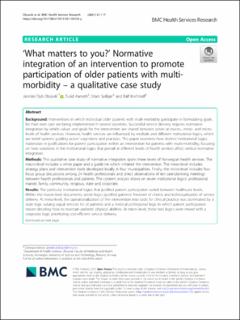| dc.contributor.author | Oksavik, Jannike Dyb | |
| dc.contributor.author | Aarseth, Turid | |
| dc.contributor.author | Solbjør, Marit | |
| dc.contributor.author | Kirchhoff, Ralf | |
| dc.date.accessioned | 2023-01-17T14:43:06Z | |
| dc.date.available | 2023-01-17T14:43:06Z | |
| dc.date.created | 2021-01-21T12:42:46Z | |
| dc.date.issued | 2021 | |
| dc.identifier.citation | BMC Health Services Research. 2021, 21 1-15. | en_US |
| dc.identifier.issn | 1472-6963 | |
| dc.identifier.uri | https://hdl.handle.net/11250/3044120 | |
| dc.description.abstract | Background: Interventions in which individual older patients with multi-morbidity participate in formulating goals for their own care are being implemented in several countries. Successful service delivery requires normative integration by which values and goals for the intervention are shared between actors at macro-, meso- and micro-levels of health services. However, health services are influenced by multiple and different institutional logics, which are belief systems guiding actors’ cognitions and practices. This paper examines how distinct institutional logics materialize in justifications for patient participation within an intervention for patients with multi-morbidity, focusing on how variations in the institutional logics that prevail at different levels of health services affect vertical normative integration. Methods: This qualitative case study of normative integration spans three levels of Norwegian health services. The macro-level includes a white paper and a guideline which initiated the intervention. The meso-level includes strategy plans and intervention tools developed locally in four municipalities. Finally, the micro-level includes four focus group discussions among 24 health professionals and direct observations of ten care-planning meetings between health professionals and patients. The content analysis draws on seven institutional logics: professional, market, family, community, religious, state and corporate. Results: The particular institutional logics that justified patient participation varied between healthcare levels. Within the macro-level documents, seven logics justified patients’ freedom of choice and individualization of service delivery. At meso-level, the operationalization of the intervention into tools for clinical practice was dominated by a state logic valuing equal services for all patients and a medical professional logic in which patient participation meant deciding how to maintain patients’ physical abilities. At micro-level, these two logics were mixed with a corporate logic prioritizing cost-efficient service delivery. Conclusion: Normative integration is challenging to achieve. The number of institutional logics in play was reduced downwards through the three levels, and the goals behind the intervention shifted from individualization to standardization. The study broadens our understanding of the dynamic between institutional logics and of how multiple sets of norms co-exist and guide action. Knowledge of mechanisms by which normative justifications are put into practice is important to achieve normative integration of patient participation interventions. | en_US |
| dc.description.abstract | 'What matters to you?' : normative integration of an intervention to promote participation of older patients with multi-morbidity - a qualitative case study | en_US |
| dc.language.iso | eng | en_US |
| dc.publisher | BMC | en_US |
| dc.relation.uri | https://doi.org/10.1186/s12913-021-06106-y | |
| dc.rights | Navngivelse 4.0 Internasjonal | * |
| dc.rights.uri | http://creativecommons.org/licenses/by/4.0/deed.no | * |
| dc.title | 'What matters to you?' : normative integration of an intervention to promote participation of older patients with multi-morbidity - a qualitative case study | en_US |
| dc.title.alternative | 'What matters to you?' : normative integration of an intervention to promote participation of older patients with multi-morbidity - a qualitative case study | en_US |
| dc.type | Peer reviewed | en_US |
| dc.type | Journal article | en_US |
| dc.description.version | publishedVersion | en_US |
| dc.source.pagenumber | 1-15 | en_US |
| dc.source.volume | 21 | en_US |
| dc.source.journal | BMC Health Services Research | en_US |
| dc.identifier.doi | 10.1186/s12913-021-06106-y | |
| dc.identifier.cristin | 1876509 | |
| dc.relation.project | Norges teknisk-naturvitenskapelige universitet: 562249 | en_US |
| cristin.ispublished | true | |
| cristin.fulltext | original | |
| cristin.qualitycode | 2 | |

